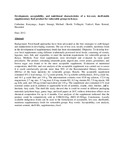| dc.description.abstract | Background. Food-based approaches have been advocated as the best strategies to curb hunger and malnutrition in developing countries. The use of low-cost, locally available, nutritious foods in the development of supplementary foods has been recommended.
Objective. To develop low-cost food supplements using different traditionally processed local foods, consisting of cereals, legumes, nuts, fish, and vegetables, to meet the nutrient requirements for vulnerable groups in Kenya. Methods. Four food supplements were developed and evaluated by taste panel procedures. The product containing amaranth grain, pigeon pea, sweet potato, groundnuts, and brown sugar was found to be the most acceptable supplement. Evaluation of nutritional composition, shelf-life, and cost analysis of the acceptable supplement was carried out to assess if it could satisfactorily
provide more than 50% of the Recommended Dietary Allowances (RDAs) of the basic nutrients for vulnerable groups. Results. The acceptable supplement contained 453.2
kcal energy, 12.7 g crude protein, 54.3 g soluble carbohydrates, 20.8 g crude fat, and 10.1 g crude fiber per 110 g. The micronutrient contents were 93.0 mg calcium, 172.4 mg magnesium, 2.7 mg zinc, 5.7 mg iron, 0.8 mg vitamin B1, 0.2 mg vitamin B2, 7.9 mg niacin, 100 µg folic acid, and 140 µg retinol equivalent per 110 g. The supplement also contained 21% total essential amino acid in addition to appreciable levels of palmitic, stearic, oleic, linoleic, and α-linolenic fatty acids. The shelf-life study showed that it could be stored in different packaging materials (polythene bags, gunny bags, and kraft paper) at 26°C without deleterious effects on its chemical composition for up to 4 months. Cost analysis of the supplement indicated that the product could be competitively sold at US$0.812/kg (KES 65.50/kg). Conclusions. Locally available indigenous foods can be used in the formulation of acceptable, low-cost, shelfstable, nutritious supplementary foods for vulnerable groups. Key words: Acceptability, cost analysis, nutrient content, shelf-life, supplementary food | en |

